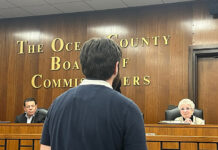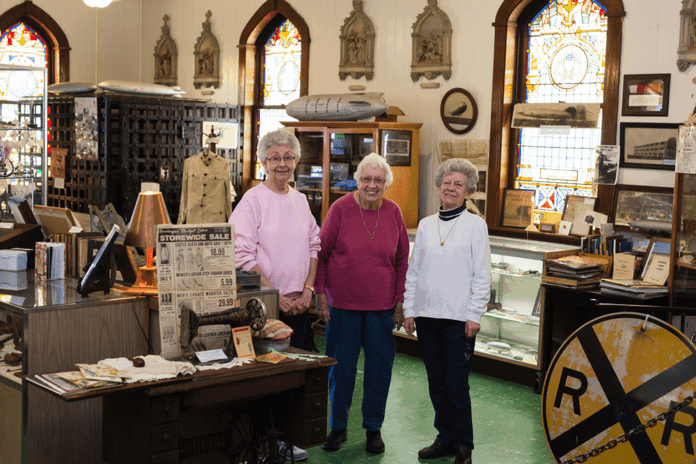
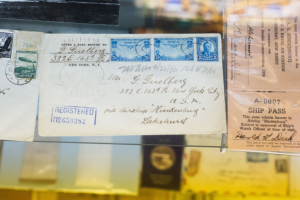
LAKEHURST – The display occupies an area under the stained-glass window in memory of Thomas and Catherine Whalen and Family. It’s one lighted case beneath that window, a case that can’t be opened to examine the items inside, and table filled with books to the right of the case. There are photographs and newspaper clippings pinned to the walls and sitting on the windowsill. On the northern side of the building, there are newspaper clippings, some from papers that no longer exist.
It’s a small part of the Lakehurst Historical Society’s museum, which occupies the Old St. John’s Church, itself Ocean County’s oldest Roman Catholic Church. But the Hindenburg remains a giant in the borough’s history.
 “You go anywhere and mention that you’re from Lakehurst, so many people associate that with the Hindenburg,” historical society volunteer Aurora Semple said. But, she added, “The Hindenburg isn’t [the historical society’s] main concern. Lakehurst has been around since Revolutionary times.”
“You go anywhere and mention that you’re from Lakehurst, so many people associate that with the Hindenburg,” historical society volunteer Aurora Semple said. But, she added, “The Hindenburg isn’t [the historical society’s] main concern. Lakehurst has been around since Revolutionary times.”
Semple and her fellow volunteers – on this Wednesday, Barbara Cummings and Bernadette Werthwein – said the museum would likely see a bump in visitors with the 80th anniversary of the Hindenburg tragedy approaching.
On May 3, 1937, the Hindenburg left Frankfurt, Germany, and made its three-day journey across the Atlantic to Lakehurst, carrying 36 passengers and 61 crew members. An advertisement discovered by Cummings revealed the price for that transatlantic trip was $400, about $7,000 per ticket in today’s dollars.
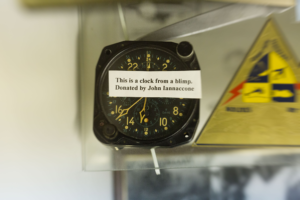
Waiting for storms to clear from the area, the Hindenburg made its final approach to Lakehurst around 7 p.m. on May 6. Eyewitness accounts have always varied, but about 25 minutes after arriving, the dirigible – the largest ever built – burst into flames, crashing to the ground in less than a minute. Thirteen passengers, 22 crewmen, and one civilian ground crewman, Allen Hagaman, died.
The crash is well documented in photographs, on-location movies, and Chicago broadcaster Herbert Morrison’s now-legendary radio commentary, which wasn’t broadcast live and is known for his desperate utterance, “oh, the humanity…”
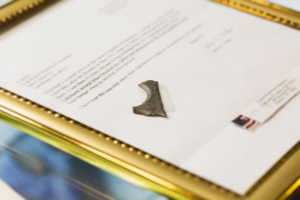
The single display case dedicated to the Hindenburg houses an eclectic collection of memorabilia and items from the dirigible itself. Letters are addressed “via airship Hindenburg, Lakehurst.” A clock from the dirigible is frozen at 12:38 p.m.
There are items that reveal the tragedy, however. The museum has several pieces of paper, one a schedule of the Hindenburg’s flight times that is singed. A woman from Florida donated a piece of rope line from the Hindenburg. Two different men, one from New York, donated pieces from the dirigible’s gas cell, constructed from a material made from brushing layers of gelatin onto cotton fabric, different from the usual goldbeater’s skin (outer member of cattle intestines, according to Airships.com). The pieces, one a larger, folded fabric, and the other, which at a particular angle looks like a giraffe’s neck and head, are a mottled gray.
Questions about the tragedy are deferred to the dozens of books on the subject. The collection sits on a table next to the display.
The museum, located at 300 Center Street, is open Wednesdays and Sundays from noon to 3 p.m.


